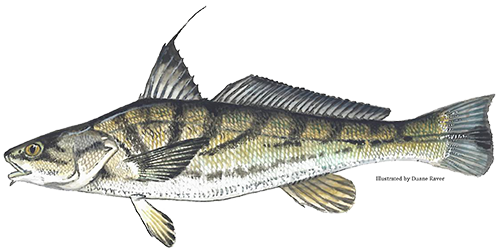| Northern Kingfish |
 |
Northern Kingfish |
| Menticirrhus saxatilis |
(A.K.A. king whiting, sea mullet, northern whiting, roundhead, sea mink, minkfish, whiting and barb)
|
Key Distinguishing Markings:
- Northern Kingfish have a long spine on the first dorsal fin and a barbel on the chin.
- Dark, irregular bars are present along the body of the fish. The first two bars form two distinct V-shapes.
- The bold markings and a dark longitudinal stripe behind the pectoral fins distinguish it from the two other species of kingfish. The markings on Southern kingfish and Gulf kingfish are not nearly as prominent and do not form the V-shaped pattern.
View the Kingfish Gallery
|
Distribution:
- Northern kingfish are found in the Atlantic Ocean from Maine to Florida and in the Gulf of Mexico from Florida to Yucatan.
- They are most commonly found from the Chesapeake Bay to New York.
|
Size:
- Northern kingfish can grow 18 inches long and can weigh up to three pounds, but greater lengths and weights have been reported.
- Commonly, these fish range from 10 to 14 inches long and weigh from one-half to 1.5 pounds.
- The largest ever recorded anywhere, a three-year-old female caught in a commercial gill net, was more than 21 inches long and weighed 3.3 pounds.
|
Habitat:
- Usually found in schools in shallow coastal waters, Northern kingfish prefer areas with a hard or a sandy bottom.
- They regularly appear along the Atlantic coast from late April to October. It is unknown where Northern kingfish migrate for the winter, but it is thought to be offshore and in deeper water.
|
Spawning:
- Spawning typically occurs at the bottom of bays and sounds, but has been reported to occur outside of estuaries.
- The spawning period ranges from April until August, depending on the region; older fish tend to spawn first.
- Males become sexually mature around age two and females around age three. The eggs float, and within 46 to 50 hours, they hatch in waters 68 to 70 degrees Fahrenheit.
|
Fishing Tips:
- Late summer produces the best results, and fishing can be done in the surf or by boat close to shore.
- Small hooks and light tackle should be used and clams, bloodworms or squid cut into bite-size pieces are the most effective bait.
- Fishing in the bay can be done by anchoring in shallow water about eight to 15 feet deep and chumming with clams.
- Some anglers like to use bobbers also. The same bait and hooks are used for surf fishing, which is the more popular method.
- Try retrieving your line slowly to improve your catch.
|
Fun Fact:
- The average life expectancy of the Northern kingfish is two to three years, although they are known to live as long as four years.
|
| Family: Sciaenidae (drums and croakers) |
| Order: Perciformes ("perch-like") |
| Class: Actinopterygii (ray-finned fishes) |
References:
- https://www.nj.gov/dep/fgw/artkingfish.htm
|
